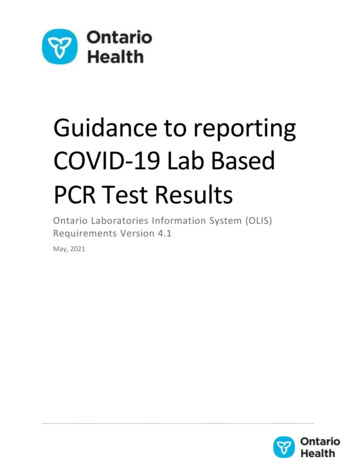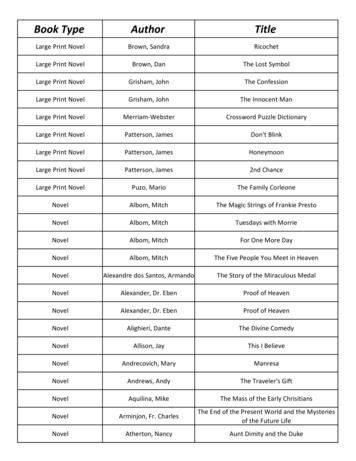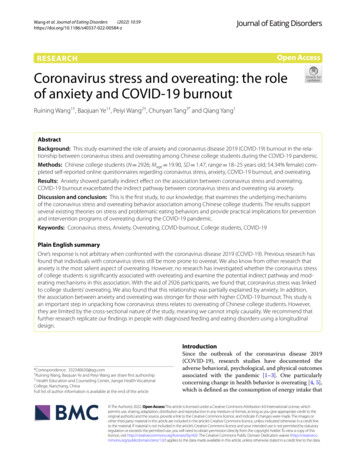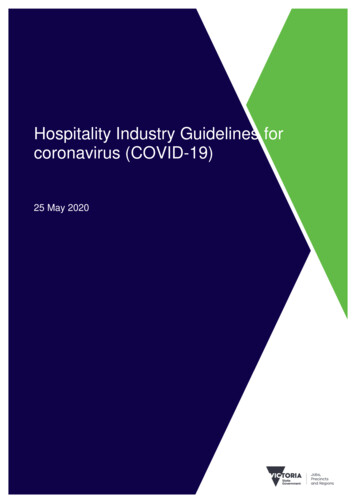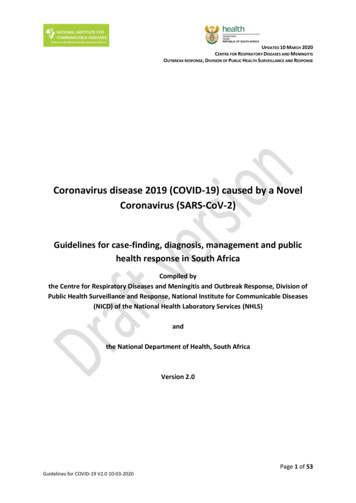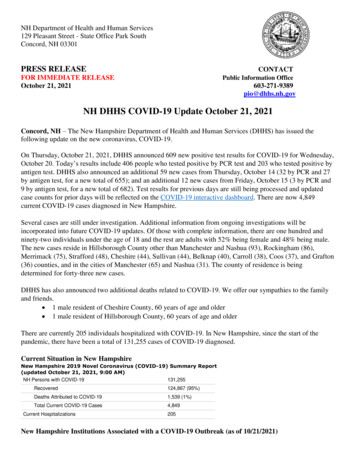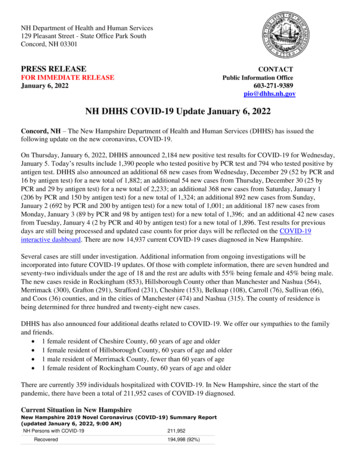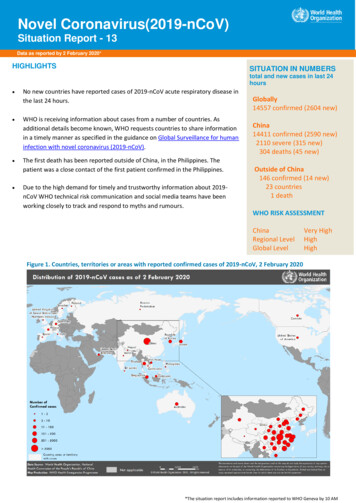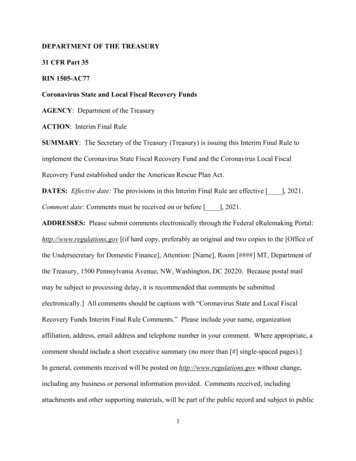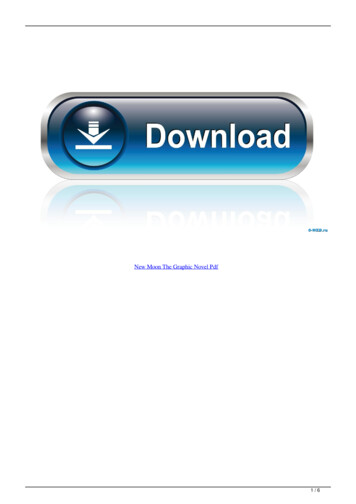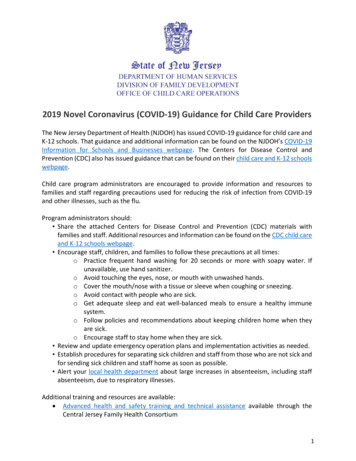
Transcription
2019 Novel Coronavirus (COVID‐19) Guidance for Child Care ProvidersThe New Jersey Department of Health (NJDOH) has issued COVID‐19 guidance for child care andK‐12 schools. That guidance and additional information can be found on the NJDOH’s COVID‐19Information for Schools and Businesses webpage. The Centers for Disease Control andPrevention (CDC) also has issued guidance that can be found on their child care and K‐12 schoolswebpage.Child care program administrators are encouraged to provide information and resources tofamilies and staff regarding precautions used for reducing the risk of infection from COVID‐19and other illnesses, such as the flu.Program administrators should: Share the attached Centers for Disease Control and Prevention (CDC) materials withfamilies and staff. Additional resources and information can be found on the CDC child careand K‐12 schools webpage. Encourage staff, children, and families to follow these precautions at all times:o Practice frequent hand washing for 20 seconds or more with soapy water. Ifunavailable, use hand sanitizer.o Avoid touching the eyes, nose, or mouth with unwashed hands.o Cover the mouth/nose with a tissue or sleeve when coughing or sneezing.o Avoid contact with people who are sick.o Get adequate sleep and eat well‐balanced meals to ensure a healthy immunesystem.o Follow policies and recommendations about keeping children home when theyare sick.o Encourage staff to stay home when they are sick. Review and update emergency operation plans and implementation activities as needed. Establish procedures for separating sick children and staff from those who are not sick andfor sending sick children and staff home as soon as possible. Alert your local health department about large increases in absenteeism, including staffabsenteeism, due to respiratory illnesses.Additional training and resources are available: Advanced health and safety training and technical assistance available through theCentral Jersey Family Health Consortium1
CDC How To Clean and Disinfect Schools To Help Slow the Spread of FluCDC Life is Better with Clean HandsNJDOH has established a hotline (1‐800‐222‐1222) to answer questions about COVID‐19.Operated by the Poison Information and Education System, the 24‐hour public hotline isstaffed with trained healthcare professionals and can accommodate callers in multiplelanguages.NJDOH’s main COVID‐19 webpageCDC Child Care and K‐12 Schools webpageThe New Jersey Department of Human Services will continue to keep child care providers andprograms updated. We encourage you to keep up‐to‐date on the latest information by checkingthe NJDOH COVID‐19 webpage and following the NJDOH on social media: Twitter@njdeptofhealth, Facebook /njdeptofhealth and Instagram @njdeptofhealth.The following pages are the March 4, 2020 NJDOH issued COVID‐19 Guidance for Child Care andK‐12 Schools, it can also be found on the COVID‐19 Information for Schools and Businesseswebpage.2
New Jersey Department of HealthCOVID-19 Guidance for Child Care and K-12 SchoolsMarch 4, 2020Many childcare centers, school administrators, teachers and parents within New Jersey are concernedabout how the current outbreak of the 2019 Novel Coronavirus (COVID-19) will impact theircommunities and wish to take appropriate steps to mitigate any risks. The word “novel” means new. TheCenters for Disease Control and Prevention (CDC) is working hard to learn as much as possible about thisnew virus so that they can better understand how it spreads and its associated illness. The New JerseyDepartment of Health is also working hard by developing guidance and education materials should thisnew virus impact our residents.Imported cases of COVID-19 in travelers have been detected in the United States. More cases are likelyto be identified in the coming days, including more cases in the United States. It’s likely that person-toperson spread will continue to occur, including in the United States. Widespread transmission of COVID19 in the United States would translate into large numbers of people needing medical care at the sametime. Schools, childcare centers, workplaces, and other places for mass gatherings may experience moreabsenteeism. Public health and healthcare systems may become overloaded, with elevated rates ofhospitalizations and deaths. Other critical infrastructure, such as law enforcement, emergency medicalservices, and transportation industry may also be affected. Health care providers and hospitals may beoverwhelmed. At this time, there is no vaccine to protect against COVID-19 and no medicationsapproved to treat it. Personal protective measures including good hygiene habits and use ofnonpharmaceutical interventions will be the most important response strategy.Though the CDC considers COVID-19 to be a serious public health concern based on current information,the immediate health risk to the general U.S. public is considered low at this time. The CDC and theWorld Health Organization are closely monitoring the national and global situation and providingongoing guidance. At this time, the CDC recommends avoiding nonessential travel to China, Iran, Italyand South Korea. There are additional countries with travel alerts. Updated travel information specific toCOVID-19 can be found at s/index.html.What is the difference between seasonal and novel coronavirus?Coronaviruses are a family of viruses and there are different types of coronavirus within that family,much like there are different types of influenza viruses. Coronaviruses in general are not new and are afrequent cause of respiratory illnesses such as the common cold. Coronaviruses tend to circulate in thefall and winter months, similar to influenza. Most people get infected with these viruses at some point intheir lives.The type of coronavirus that has recently emerged in Wuhan, China is a new type of coronavirus and isinfecting people for the first time (which means that people do not have any immunity to it). This newlydiscovered virus is called SARS-CoV-2 and is causing a disease named COVID-19.1
What are common symptoms of COVID-19?Information to date suggests this virus is causing symptoms consistent with a respiratory illness such ascough, fever, and shortness of breath.How is COVID-19 spread?At this time, it’s unclear how easily or sustainably this virus is spreading between people. Typically, withmost respiratory viruses, people are thought to be most contagious when they are most symptomatic(the sickest). Chinese officials report that sustained person-to-person spread in the community isoccurring in China. Similar spread has been reported in other countries. Person-to-person spread in theUnited States has been detected but the risk to the general public remains low. Cases in healthcaresettings, like hospitals, may also occur.What measures can be taken to prevent COVID-19?There is currently no vaccine to prevent COVID-19 infection. The best way to prevent infection is toavoid being exposed to this virus. However, as a reminder, CDC always recommends everydaypreventive actions to help prevent the spread of respiratory viruses.How is COVID-19 treated?Currently, there is no specific antiviral treatment recommended for the coronavirus. There is no vaccineto prevent this virus, and the CDC advises that the best way to prevent infection is to avoid beingexposed to this virus.How should schools prepare for the potential of a coronavirus outbreak in their community?To prepare for possible community transmission of COVID-19, the most important thing for schools todo now is plan and prepare. Interim Guidance for Administrators of US Childcare Programs and K-12Schools to Plan, Prepare, and Respond to Coronavirus Disease 2019 (COVID-19) can be found ic-groups/guidance-for-schools.html. Review and update or develop your outbreak response/pandemic plan and share withstakeholders before an outbreak occurs.Establish procedures to ensure students and staff who become sick at school or arrive at schoolsick are sent home as soon as possible.Prepare for the potential of school closures or dismissals or cancellation of school events.Prepare to offer home instruction to students.Implement flexible attendance and sick leave policies.Establish relationships with local public health officials and identify points of contact.Create emergency communication plan and maintain up to date contact information foreveryone in your communication chain.Establish leadership team, identify essential staff functions, assign tasks and responsibilities.2
Plan workshops and trainings to educate staff on prevention measures.Continue to monitor current information from health officials.What should a school do when a student or staff presents with symptoms of COVID-19? COVID-19 presents with signs and symptoms that may be indistinguishable from much morecommon respiratory viruses. At this time, respiratory illnesses are much more likely to be due tocommon viruses (e.g., influenza, common cold) than COVID-19. If a community (or morespecifically, a school) has cases of COVID-19, local health officials will help identify thoseindividuals and will follow up on next steps. Schools are not expected to screen students or staffto identify cases of COVID-19. Students with fever, cough, or difficulty breathing should be placed away from others and askedto wear a face mask until they can be sent home. Staff members should be sent home and advised to seek medical advice. Notify your local health department with any questions or concern about an ill studentwww.localhealth.nj.gov.Will schools be asked to close if there is a COVID-19 outbreak in the community? Non pharmaceutical interventions (NPIs) are strategies that can be used when other measureslike treatment or vaccines are not available to combat an emerging illness with pandemicpotential.o School closures and school dismissals are two recommended strategies to limittransmission within the community.o During school dismissals, childcare programs and schools may stay open for staff (if notill) while students stay home. This allows teachers to develop and deliver lessonsremotely and for other staff to continue to provide services.Schools may be asked to close preemptively or reactively, therefore schools should be makingplans for what to do if there are recommendations for closing schools or cancelling events.Childcare and school administrators should work closely with local health officials when makingdecisions on dismissals or closures.What if a student/staff recently returned from travel to a country (other than China) where a travelalert has been issued?CDC has issued travel advisories for several countries /index.html. Students and staff returning from the countries with widespread sustainedtransmission should follow recommendations provided by CDC ers/after-travel-precautions.html.If there is a student or staff member who recently returned from China in the past 14 days, shouldthey be excluded from work or school? Travelers returning from mainland China will undergo a health screening and up to 14 days ofself-quarantine with health monitoring to ensure they have not contracted the virus and do notpose a public health risk.3
All asymptomatic (without symptoms) students/staff under monitoring must be excluded fromwork and school for 14 days from their last date in China.Travelers will be asked to self-quarantine and self-monitor as directed by public healthrecommendations and to seek care if ill.Schools should be prepared to offer alternate instruction while student is quarantined. Pleaseconsult NJDOE regarding home instruction.When can a student or staff member return to school/work after being quarantined or self-isolated?Travelers who have been quarantined for 14 days and have remained asymptomatic may return toschool unless they meet other criteria for school exclusion (see link to exclusion list below).Is a physician letter required for the student to return to school after their monitoring period iscomplete?Returning travelers under monitoring are not being monitored by their healthcare provider. If a letter isrequested, the monitoring agreement the individual or guardian signs would serve as proof that themonitoring period is complete.Students are going for spring break; can they still go?Prior to traveling, individuals should consider the potential risks that may be involved in visiting theirdestination, including risk of transmission as well as the risk of quarantine upon returning. Destinationsexperiencing sustained community transmission should be avoided. Any person or group planning a tripoutside of the United States should consult the CDC website for current travel advisories regarding anyrestrictions on travel. The situation is evolving. Stay up to date with CDC’s travel health notices relatedto this outbreak at s/index.html. These noticeswill be updated as more information becomes available.Do school events need to be canceled?At this time, there is no need to cancel school or social events. There are no cases of COVID-19 in NewJersey, and there are no restrictions on public gatherings. Students should be reminded that part ofgood respiratory hygiene is staying home from events when they are ill. If COVID-19 is occurring in yourcommunity, public health may recommend modifying, postponing, or cancelling mass gatherings.What preventive measures should a school take to help reduce the spread of respiratory illnessincluding COVID-19 and the flu?NJDOH recommends that schools and childcare settings increase education on respiratory hygiene. Staffand children (as developmentally appropriate) should all be taught and asked to follow these steps thatprevent the transmission of respiratory infections: Cover your coughs and sneezes with a tissue or into your sleeve, not your hands.Avoid touching your eyes, nose and mouth.4
Wash hands often for at least 20 seconds, especially after coughing or sneezing. Use alcoholbased hand sanitizer if soap and water are not available.Stay home if you’re sick, especially with a fever.Avoid people who are sick.Clean and disinfect frequently touched surfaces and objects.Additional preventive measures include: Continue to monitor students and staff who my exhibit respiratory symptoms. Adhere to exclusion recommendations from public health. For acute respiratory illness; feverfree for 24 hours without fever-reducing medication. Doctors notes for return do not supersedepublic health recommendations. Separate sick students and staff from others until they can be picked up to go home. Provide adequate supplies, including clean and functional handwashing stations, soap, papertowels, and alcohol-based hand sanitizer. Encourage routine surface cleaning through education, policy, and the provision of supplies. Get a flu shot – it’s not too late to be protected!School Cleaning ProceduresSpecial sanitizing processes beyond routine cleaning, including closing schools to clean every surface inthe building are not necessary or recommended to slow the spread of respiratory illness. Schools shouldfollow standard procedures for routine cleaning and disinfecting with an EPA-registered product.Typically, this means daily sanitizing surfaces and objects that are touched often, such as desks,countertops, doorknobs, computer keyboards, hands-on learning items, faucet handles, phones andtoys.Outbreaks involving novel coronaviruses evolve quickly and recommendations from public healthofficials may change frequently as new information becomes available. Please check the followingwebsites often for updated information. Centers for Disease Control and Prevention Centers for Disease Control and Prevention: o Coronavirus Disease 2019 (COVID-19)o Guidance for Schools 2019-ncovo Get Your School Ready for Pandemic FluNew Jersey Department of Health: o Novel Coronavirus COVID-2019o School Health htmlo School Exclusion Listo Local Health Department Directory www.localhealth.nj.govReadiness and Emergency Management for Schools (REMS) Technical Assistance (TA) CenteroReadiness and Emergency Management for Schools5
The Centers for Disease Control and . COVID-19 Guidance for Child Care and K-12 Schools . March 4, 2020 . Many childcare centers, school administrators, teachers and parents within New Jersey are concerned . Coronaviruses are a family of viruses and there are different types of coronavirus within that family,

